Has the Invasion Started? Asian Carp eDNA Found in Lake Erie
While federal efforts are largely focused on stonewalling invasive Asian carp at Chicago, the fish could be making their way into the Great Lakes through Lake Erie, where studies show they are likely to thrive.
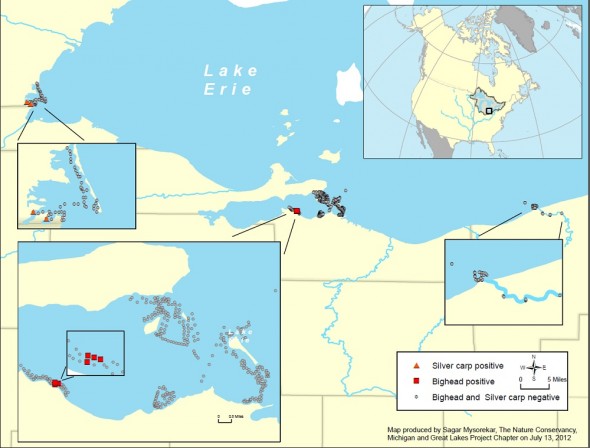
By Codi Yeager-Kozacek
Circle of Blue
Six water samples taken from Lake Erie have tested positive for Asian carp environmental DNA (eDNA), suggesting — but not concluding — that the invasive fish are present in the Great Lakes.
The samples were collected in August 2011 by the Ohio and Michigan Departments of Natural Resources (DNR), but were only recently analyzed and confirmed. Four of the samples, taken from Sandusky Bay in Ohio waters, were positive for bighead carp. The other two samples, taken from Maumee Bay in Michigan waters, were positive for silver carp, according to the DNR.
“The results from these water samples are certainly concerning, as this marks the first time Asian carp eDNA has been detected in water samples from Lake Erie, or any of the Michigan waters intensively surveyed for the presence of invasive carp,” Jim Dexter, fisheries division chief for the Michigan DNR, said in a press release.
The silver and bighead carp species are among four Eurasian carp that were introduced to aquaculture facilities in the southern United States in the 1970s — the other two are grass carp and common carp — and which have since spread throughout much of the Mississippi River Basin to the detriment of many native fish species and aquatic habitats. If the Asian carp infiltrate the Great Lakes, it is predicted that they could severely disrupt the region’s $US 7 billion sport-fishing industry.
Thus far, federal and state efforts to stop the advance of the Asian carp have focused primarily on the Chicago Area Waterway System (CAWS), a series of canals and channels that links the Mississippi River Basin and the Great Lakes Basin. The CAWS currently has three electric dispersal barriers, which create an electrical field in the water to deter fish from swimming upstream to Lake Michigan and which have been operated by the U.S. Army Corps of Engineers since 2002.
There is much debate about whether or not the barriers provide adequate protections from Asian carp — 28 water samples taken upstream of the barrier have tested positive for carp eDNA in 2012 — and some Great Lakes state governments and advocacy groups argue that a permanent return to the natural separation of the two watersheds is the only way to effectively stop the movement of invasive species.
But plans for hydrological separation of the basins in Chicago could cost between $US 3.26 billion and $US 9.54 billion, and would likely not take effect until 2022, according to an assessment released earlier this year by the Great Lakes Commission and the Great Lakes and St. Lawrence Cities Initiative.
Meanwhile, just last month, the U.S. Congress passed a measure requiring the Army Corps of Engineers to speed up the official federal study on ways to stop the carp, moving the deadline from 2015 to the end of 2013. President Barack Obama signed the act into law earlier this month, and the decision has been heralded as a big win for the Great Lakes.

An Invasion of Lake Erie
The CAWS remains the “most likely point of direct arrival into the Great Lakes Basin,” but Eagle Marsh in Indiana could also be a high-risk pathway, according to a recent bi-national risk assessment released by the Department of Fisheries and Oceans Canada and the United States Geological Survey.
Eagle Marsh sits in northeastern Indiana, between the Wabash River system in the Mississippi River Basin and the Maumee River system that flows into Lake Erie. During floods, water levels are sufficient for fish movement between the two basins. A mesh fence is currently employed in the marsh to stop Asian carp from passing into the Maumee River system.
“Eagle Marsh provides conditions suitable for bigheaded carp movement and is in proximity to bigheaded carp populations,” states the risk assessment. “However, this area is not suitable for spawning; therefore, the potential movement is limited to adults only.”
Human-facilitated movement of Asian carp through baitfish and live fish markets also pose threats, and — together with natural means — the probability of Asian carp introduction is ‘very likely,’ or there is a 95 percent to 100 percent chance of occurrence, for lakes Erie, Huron, and Michigan, according to the risk assessment. These probabilities were given a ‘high’ level of certainty, meaning that the probabilities are accurate by +/-30 percent, and the chance that Asian carp will be successfully introduced into these three lakes is at least 65 percent.
The positive eDNA samples from Lake Erie could mean that the fish have already reached the Great Lakes. The six positives represent only 1.4 percent of the 417 samples taken from the lake, but the recent risk assessment cautions that eDNA testing — which can detect genetic material like mucus, feces, or scales in the water — may underestimate the actual numbers.
“It is important to note that the rate of false positives of eDNA (detecting bigheaded carp DNA when not present) is at or near zero, but that eDNA can degrade quickly and that false negatives (no indication of a bigheaded carp when species is present) for this and traditional capture methods may be high,” the report stated. “However, collection of bigheaded carp eDNA is not incontrovertible evidence of the presence of a live bigheaded carp, because eDNA can be transported without a live fish.”
The Tipping Point
Even so, the presence of one Asian carp in the Great Lakes would be unlikely to cause any damage, because it would not be able to reproduce. For Asian carp to spawn and establish a breeding population in the lakes, models reported in the risk assessment estimate that 10 male and 10 female fish would be required under ideal conditions, while 20 males and 20 females would be required under less ideal conditions.
One bighead carp in North America can produce anywhere from 4,792 eggs to 1.6 million eggs in a single spawn, while a silver carp can produce between 26,650 eggs and 3.7 million eggs, according to studies reported in the risk assessment.
Lake Erie, as the shallowest and warmest of the Great Lakes, would provide conditions conducive to Asian carp spawning and development.
“Results of the risk assessment show that there is enough food and habitat for bigheaded carp survival in the Great Lakes, especially in Lake Erie and productive embayments in the other lakes,” states the risk assessment. “Lakes Erie and St. Clair are the warmest and most eutrophic of the Great Lakes, and they are supplied by rivers such as the Maumee and the Thames, which are possibly the most likely rivers in this system to provide for spawning and recruitment of bigheaded carps.”
A large population of bighead carp in Lake Erie could have severe negative impacts on native fish such as walleye, yellow perch, lake trout, and rainbow trout.
Source: Alliance For The Great Lakes; Michigan DNR; US Army Corps of Engineers; USGS;
A news correspondent for Circle of Blue based out of Hawaii. She writes The Stream, Circle of Blue’s daily digest of international water news trends. Her interests include food security, ecology and the Great Lakes.
Contact Codi Kozacek

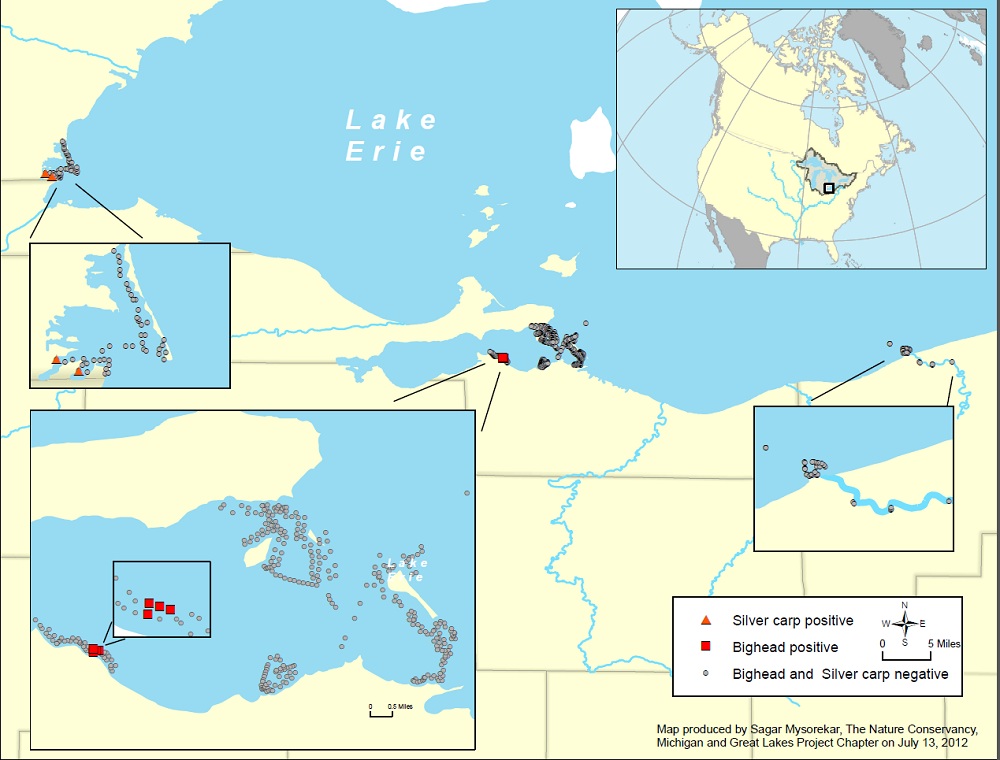



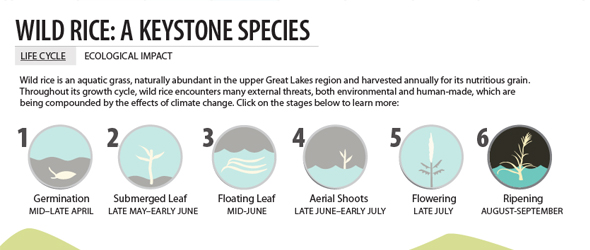
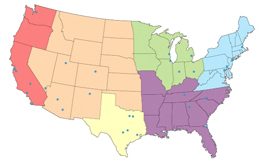
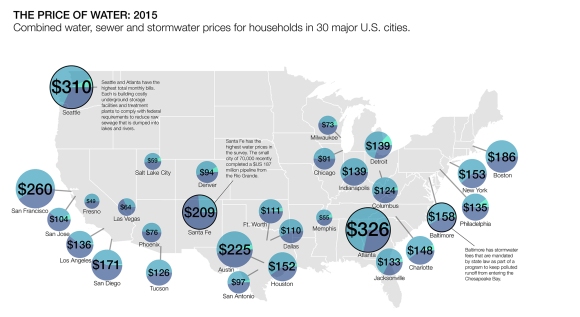




All biological life in nature will move to areas where it is easier to survive and before lands was claimed; the same did humans, while some still do. The first question why Asian carps are moving in has a simple answer; they like the conditions, since there is plenty of alga for them to eat. The second question is why there is so much algae and here the answer is too much fertilize entering our open waters, or as now called to much nutrients, EPA mostly blames on the runoffs from farms and cities. What however hardly anybody knows is that the nitrogenous waste (urine and protein) is sewage is not required to be treated under the Clean Water Act CWA), while this waste, besides exerting an oxygen demand like fecal waste, also is a fertilizer for algae and thus contributes to not only the food source for the Asian carp, but also is causing dead zones in many open waters.
The reason that nitrogenous waste is not required to be treated, is the result of the fact that when EPA implemented the CWA, it used an essential pollution test incorrect and ignored 60% of the pollution in sewage, among the waste ignored all the nitrogenous waste. EPA in 1983 acknowledged the problems with this test, but never corrected the test, while we still do not know how sewage is treated and what the effluent waste load from sewage treatment plants. In spite of this, EPA has refused to correct the test and all official attempts to correct the test during the past 30 years have been in vain, while this test clearly caused the failure of the CWA. A recent petition on http://www.change.org is trying to correct this issue by bringing this issue to the attention of members of Congress and the media, an effort one can support by clicking on http://www.change.org/petitions/members-of-congress-demand-epa-correct-a-test-that-caused-the -failure-of-the-clean-water-act.